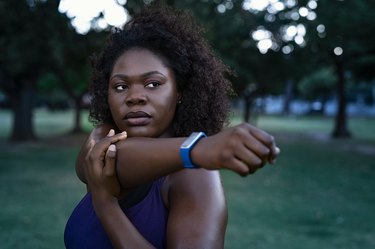
Although serious injury is rare, bruising and soreness are common when you have blood drawn. You should drink plenty of water the day of the draw, keep your arm warm beforehand and dangle your arm to increase blood pressure at the site.
If your arm is sore after blood draw, icing the area and stretching the muscles of your arm may help reduce any referred pain.
Video of the Day
Video of the Day
Read more: The Best Foods to Eat After You Give Blood
Exercising After Blood Draw
Before stretching or exercising after a blood draw, be sure that it is safe to do so. The puncture site should not be bleeding and pain should be minimal. If there is persistent dizziness or extreme pain present, contact a doctor immediately.
According to the American Red Cross, heavy exercising or lifting should be avoided for 5 hours after blood donation. Although you might not have had that much blood removed during your blood draw, the blood vessels are still traumatized.
Move 1: Standing Biceps Stretch
The standing biceps stretch will improve arm circulation while stretching the biceps and shoulders.
- Stand with feet hip-width apart.
- Clasp your hands behind your back and raise the clasped hands up from the sacrum slightly. The thumbs of both hands should be facing down toward the floor and the arms fully extended.
- Keep a slight bend in the arms to avoid locking the elbows. Gently lift the hands up toward the base of the skull while pulling the shoulder blades together to support the chest.
- When you have reached a comfortable stretch, hold for a count of 15 pain-free seconds.
Move 2: Arm Across Deltoid Stretch
This stretch, as demonstrated by the American Academy of Orthopaedic Surgeons, focuses on the deltoid muscle located on the upper part of the arm.
- Standing with feet planted firmly on the floor, hold one arm straight in front of you.
- Move the arm across the chest, holding it straight, palm facing down.
- With the other arm, pin the stretched arm to the chest just above the elbow.
- Use the bent arm to pull the stretched arm in toward the body. This will automatically straighten the stretched arm further.
- Hold the stretch for 15 seconds and release.
Move 3: Triceps Stretch
The triceps muscle is located on the back of the arm, directly opposite the biceps muscle.
- Stand with feet apart and extend the arm above your head — fingertips pointing up toward the ceiling.
- Bend the arm at the elbow, resting your fingers — palm down — on the upper back. Only stretch as far as you are comfortable — resting the hand on the back of the neck is acceptable as well.
- Take the other hand and push the elbow gently as the hand of the stretched arm moves further down the spine for a deeper stretch.
- Hold for 15 seconds and release, taking care not to overstretch.
Read more: What to Eat After You Lose Blood
Try Other Treatment Methods
While stretches might help with stiffness after a blood draw, other home remedies are also beneficial if you have pain in an arm after blood draw or other negative side effects.
If you feel lightheaded, Mayo Clinic recommends lying down with your feet elevated. Over the counter medications might help if your arm hurts after blood draw.
If your skin is bruised, apply an ice pack within the first 24 to 48 hours, as recommended by the Cleveland Clinic. Apply the ice for up to 15 minutes at a time.